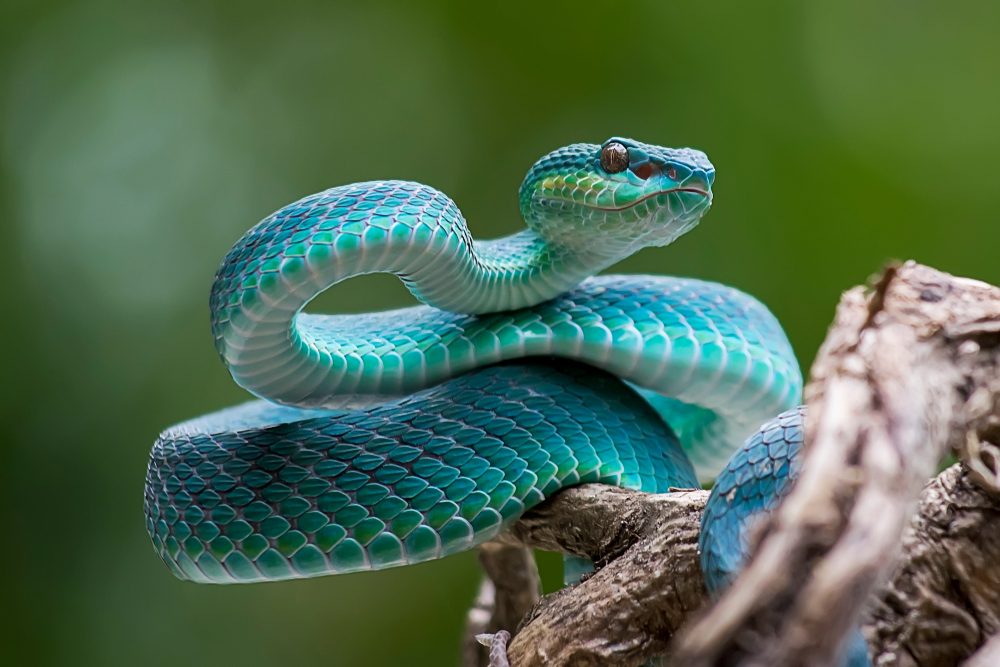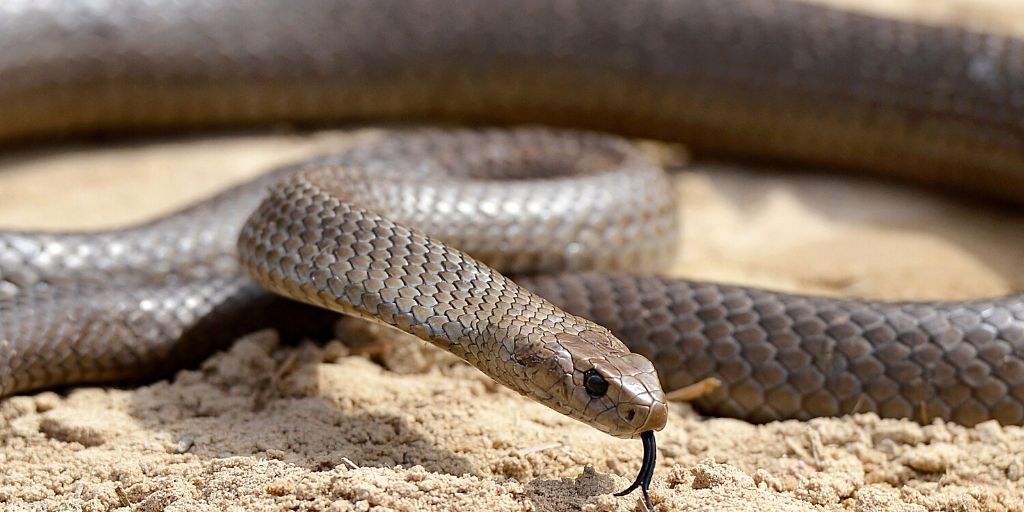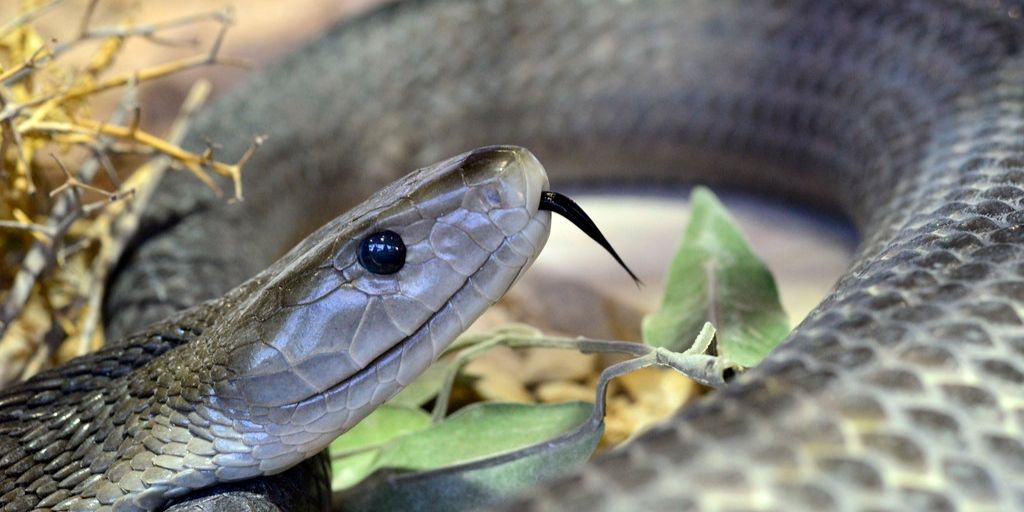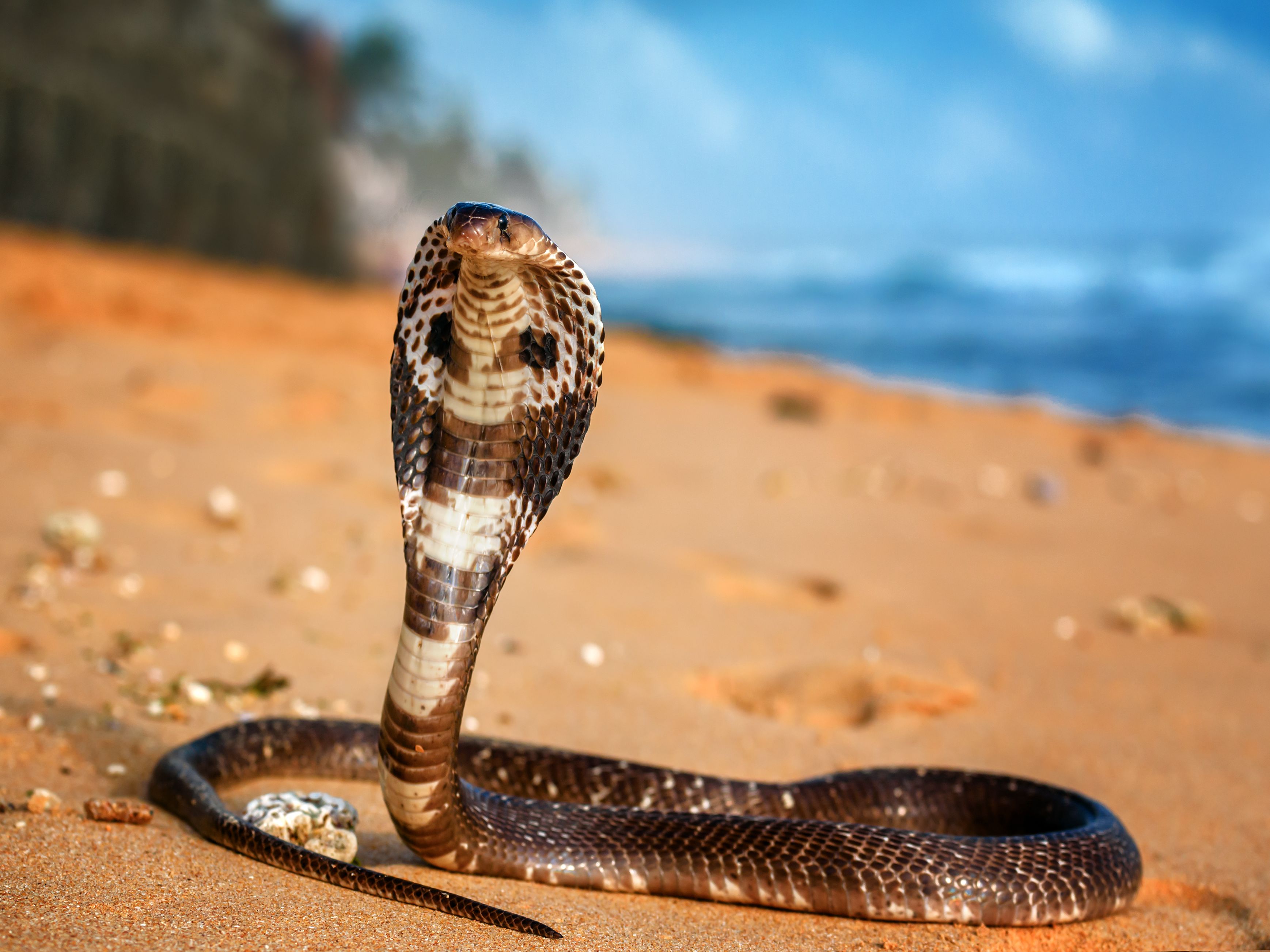Snakes are among the most efficient predators ever produced by evolution. Over millions of years, certain species have developed venom not just as a weapon for hunting, but also as a powerful deterrent against much larger threats. Some of these animals are capable of delivering venom potent enough to kill prey many times their own size. In extreme cases, the venom injected during a single bite can overwhelm even massive animals; the bite of a king cobra, for example, has been documented as capable of killing an elephant under the right conditions.
Despite the fear they inspire, snakes are not creatures that actively seek conflict with humans. Their reputation has far more to do with misunderstanding than intent. As herpetologists frequently point out, snakes do not hunt people, nor do they attack without reason. Most bites occur when a snake is startled, cornered, stepped on, or otherwise forced into a defensive situation. When escape is not possible, a snake relies on the few tools it has available: warning displays, retreat, or a bite. In venomous species, that bite simply happens to carry an extraordinarily powerful chemical payload.
The danger posed by a venomous snake is not determined by a single factor. Venom toxicity is important, but so is the volume of venom delivered, the location of the bite, the size and health of the victim, and how quickly medical treatment is received. Scientists often use a standardized measure known as LD50, which refers to the amount of venom required to kill 50 percent of test animals under controlled conditions. While this metric allows for objective comparison, it does not tell the entire story of real-world risk.
According to data compiled by the World Health Organisation, there are more than 600 species of venomous snakes worldwide. Of these, only a fraction pose a serious threat to humans, and an even smaller number are responsible for the majority of snakebite-related deaths. Human fatalities are often influenced more by geography and human activity than by venom strength alone, with snakes living near dense populations causing far more harm overall than extremely venomous species that rarely encounter people.

There are many ways to define what makes a snake “most venomous.” Some rankings focus purely on venom toxicity, while others consider how much venom a snake can inject in a single strike. Some lists prioritize overall danger by examining how many human deaths a species causes annually, or the likelihood of death when a bite is left untreated. Each approach highlights a different aspect of risk, and none tells the full story on its own.
For this reason, the following list takes a broader view. It considers venom potency, delivery efficiency, behavior, geographic range, and real-world impact on humans. The result is an objective overview of eleven snake species widely regarded as among the most venomous on Earth, along with key details that explain why each one has earned its reputation.
1. Inland Taipan
(Oxyuranus microlepidotus)
Widely accepted as the most venomous snake in the world, the inland taipan has earned the ominous nickname “the fierce snake.” Native to the arid regions of central Australia, this species lives far from major population centers, which is one of the few reasons it is not responsible for more human fatalities.
The inland taipan’s venom is an extraordinarily complex cocktail dominated by taipoxin, a combination of neurotoxins, procoagulants, and myotoxins. Together, these compounds disrupt nerve signaling, destroy muscle tissue, and interfere with blood clotting, leading to widespread internal bleeding and rapid organ failure. The venom also severely impairs breathing, often resulting in respiratory collapse if treatment is delayed.
Untreated bites from an inland taipan are lethal in the vast majority of cases, with some estimates placing the fatality rate above 80 percent. Death can occur in well under an hour, making this snake a medical emergency of the highest order. Fortunately, the species is shy and reclusive, and confirmed human deaths are extremely rare due to both avoidance behavior and modern antivenom availability.
2. Eastern Brown Snake (Common Brown Snake)
(Pseudonaja textilis)
The eastern brown snake is one of the most dangerous snakes in the world not only because of its venom, but because of how frequently it encounters humans. Found across eastern and central Australia as well as parts of southern New Guinea, this species thrives in farmland, grasslands, and suburban environments.
Slender and fast-moving, eastern brown snakes can grow up to two meters in length and are known for their agility and alertness. Their coloration varies widely, ranging from pale tan to deep brown or nearly black, often with a lighter underside. Despite their name, their appearance can differ significantly depending on habitat.
This species is considered the second-most venomous land snake on Earth and is responsible for a large proportion of snakebite deaths in Australia. When threatened, it raises its head and forms an S-shaped coil before striking with remarkable speed. Bites often occur on the lower limbs, particularly the thigh or leg.
The venom primarily targets the circulatory system, causing internal bleeding, cardiovascular collapse, and, in severe cases, cardiac arrest. Even small amounts of venom can be fatal if not treated promptly, making rapid medical intervention critical.
3. Coastal Taipan
(Oxyuranus scutellatus)
The coastal taipan, sometimes called the eastern taipan, inhabits coastal regions of northern and eastern Australia as well as parts of New Guinea. Closely related to the inland taipan, it produces venom of nearly equal potency, making it one of the most dangerous snakes on the planet.
This snake has a long, narrow head and a slender body, with coloration ranging from light olive to dark brown or black. When hunting, the coastal taipan exhibits a distinctive strategy: it freezes upon spotting prey, then launches forward with a rapid series of precise bites before retreating to allow the venom to take effect.
Its venom acts quickly, attacking the nervous system, muscles, and blood simultaneously. In the wild, this efficiency ensures prey succumbs rapidly, reducing the risk of injury to the snake itself. In humans, untreated bites can be fatal within hours.
Although generally nervous and quick to flee, coastal taipans can become highly defensive if cornered. Their combination of speed, venom potency, and large venom yield makes them especially dangerous in close encounters.
4. King Cobra
(Ophiophagus hannah)
The king cobra holds the distinction of being the largest venomous snake in the world, with adults reaching lengths of up to 5.5 meters. Native to forests across South and Southeast Asia, including India, Indonesia, and the Philippines, this species commands both fear and respect.
Unlike many venomous snakes, the king cobra primarily preys on other snakes, a trait reflected in its scientific name, which translates to “snake eater.” Its venom is less potent drop-for-drop than that of some smaller species, but the sheer volume injected during a bite makes it exceptionally dangerous.
Untreated bites have a fatality rate of around 50 percent in humans. In rare cases, the venom dose is sufficient to kill large animals, including elephants, within a matter of hours. The venom attacks the nervous system, leading to paralysis, respiratory failure, and cardiac arrest.
King cobras are intelligent and aware of their surroundings. When threatened, they can raise a third of their body off the ground, spread their hood, and emit a deep hiss as a warning. Despite this intimidating display, they typically avoid unnecessary conflict unless provoked or defending a nest.
5. Black Mamba
(Echis carinatus)
The black mamba is one of Africa’s most feared snakes, known for its speed, agility, and potent venom. Found primarily in the dry savannas and bushlands of eastern and southern Africa, this species has become legendary in both folklore and modern accounts.
Reaching lengths of up to four meters, the black mamba is slender, muscular, and capable of short bursts of speed approaching 19 kilometers per hour. It moves using lateral undulation, forming S-shaped curves and pushing off surrounding objects to gain momentum.
The venom is a powerful neurotoxin that acts rapidly on the nervous system, often causing paralysis and respiratory failure. Without antivenom, bites are frequently fatal. Historically, mortality rates were extremely high, though modern treatment has significantly improved survival when administered quickly.
Although often described as aggressive, black mambas generally attempt to flee when given the opportunity. However, if cornered or repeatedly provoked, they will stand their ground and strike with remarkable precision, sometimes delivering multiple bites in rapid succession.
6. Barba Amarilla (Common Lancehead, Fer-de-Lance)
(Bothrops atrox)
Known locally as the “yellow beard,” the barba amarilla is one of the most feared snakes in Central and South America. This reputation is well earned, not only because of its venom, but also due to its temperament, camouflage, and tendency to live near human settlements. It thrives in rainforests, plantations, agricultural fields, and even the outskirts of villages, which greatly increases the chance of encounters.
Barba amarillas typically grow up to around 1.8 meters in length, with females generally larger and heavier than males. Their broad, triangular heads are clearly set apart from the neck, housing long, hinged fangs capable of delivering large volumes of venom. Their coloration blends seamlessly into forest floors, fallen leaves, and muddy terrain, making them difficult to spot until it is too late.
The venom of the barba amarilla is primarily necrotizing and hemotoxic. It causes intense pain, massive tissue destruction, severe swelling, and internal bleeding. In many cases, untreated bites lead to permanent tissue damage, loss of limbs, or death. This species is also known for its ability to strike with great speed and from an elevated position, sometimes launching nearly two meters forward.
Unpredictable behavior, high venom yield, and proximity to people make the barba amarilla one of the most dangerous snakes in the Americas, even when compared to species with more potent venom on paper.
7. Banded Krait
(Bungarus fasciatus)
The banded krait is a strikingly patterned snake found across the Indian subcontinent and much of Southeast Asia. Its bold black and yellow bands make it visually distinctive, and its body features a prominent ridge along the spine that gives it a triangular cross-section.
Reaching lengths of over two meters, this krait is relatively slow-moving during the day and tends to be nocturnal. It often shelters in burrows, under debris, or near water sources. Despite its size and venom potency, the banded krait is generally shy and avoids confrontation whenever possible.
Its venom is highly neurotoxic, targeting the nervous system and interfering with muscle control. Bites can lead to progressive paralysis, respiratory failure, and eventual suffocation if the diaphragm becomes immobilized. One of the dangers associated with krait bites is that initial symptoms may be mild or delayed, causing victims to underestimate the seriousness of the situation.
Although the mortality rate for untreated bites is lower than that of some other snakes on this list, estimated at around 10 percent, the risk remains significant due to delayed symptom onset and limited access to medical care in many regions where the banded krait lives.
8. Boomslang
(Dispholidus typus)
The boomslang is a highly venomous tree-dwelling snake native to sub-Saharan Africa. It has a distinctive appearance, with a large, egg-shaped head, oversized eyes, and a slender body that can reach lengths of up to 1.6 meters. Its Afrikaans name translates to “tree snake,” a fitting description of its arboreal lifestyle.
This species is an ambush hunter, often positioning itself motionless among branches while mimicking the shape of a twig. From this vantage point, it strikes birds, lizards, and small mammals with impressive accuracy. Unlike many venomous snakes, the boomslang has rear-mounted fangs, but these are large and efficient, allowing it to deliver venom effectively.
Boomslang venom is a powerful hemotoxin that disrupts blood clotting. Victims may experience both internal and external bleeding, sometimes hours after the bite. One of the most dangerous aspects of boomslang envenomation is the delayed onset of severe symptoms, which can lull victims into a false sense of security.
Generally timid by nature, boomslangs rarely bite humans unless provoked. Defensive behavior includes inflating the neck and forming an S-shaped posture, but most bites occur when individuals attempt to handle or kill the snake.
9. Saw-scaled Viper
(Echis carinatus)
The saw-scaled viper is arguably the deadliest snake in the world when measured by human fatalities rather than venom potency. Found across parts of India, the Middle East, and Central Asia, this small but aggressive viper is responsible for an enormous number of snakebite deaths each year.
Despite its relatively modest size, the saw-scaled viper is highly irritable and quick to strike. It gets its name from the serrated edges of its scales, which it rubs together to produce a rasping warning sound when threatened. This audible signal often precedes a rapid and repeated series of strikes.
Its venom is hemotoxic and cytotoxic, causing tissue damage, severe pain, and bleeding disorders. While the fatality rate of untreated bites is lower than that of some other species on this list, often estimated at under 10 percent, the sheer frequency of bites makes this snake exceptionally dangerous.
Saw-scaled vipers frequently inhabit densely populated rural areas, agricultural fields, and rocky terrain near human dwellings. Their tendency to bite readily and their proximity to people explain why they are linked to more deaths annually than any other snake species.
10. Tiger Snake
(Notechis scutatus)
Tiger snakes are among the most venomous reptiles found in Australia, inhabiting southern regions of the continent as well as coastal islands, including Tasmania. They are named for their characteristic banding, though coloration varies widely from pale yellow to deep black depending on habitat and temperature.
These snakes are highly adaptable and can be found near wetlands, grasslands, and urban areas. Their venom is a potent blend of neurotoxins, myotoxins, coagulants, and hemolysins, making it extremely dangerous if left untreated.
Bites from tiger snakes can cause paralysis, muscle breakdown, severe pain, and blood clotting disorders. Historically, fatality rates were high, but modern antivenom has significantly reduced deaths. Even so, tiger snakes are responsible for a notable proportion of snakebite cases in Australia.
Although generally defensive rather than aggressive, tiger snakes will stand their ground if threatened, flattening their bodies and raising their heads in a display meant to deter predators or perceived threats.
11. Faint-banded Sea Snake (Belcher’s Sea Snake)
(Hydrophis belcheri)
The faint-banded sea snake is often cited as one of the most venomous snakes in the world based purely on venom toxicity. It inhabits warm coastal waters from the Indian Ocean through the Gulf of Thailand and into the seas surrounding northern Australia.
Adults typically reach around one meter in length and are easily recognized by their slender yellowish bodies marked with dark green or bluish crossbands. Like most sea snakes, they are fully adapted to marine life, with paddle-shaped tails and the ability to absorb oxygen through their skin.
Despite its extreme venom potency, this species is remarkably timid. Bites are rare and usually occur only when fishermen accidentally entangle the snake in nets or attempt to handle it. When venom is injected, even a very small amount can be lethal, with laboratory measurements placing its toxicity among the highest of any snake.
Fortunately, the faint-banded sea snake often delivers dry bites or minimal venom during defensive encounters, which significantly reduces the number of fatalities associated with this species.
The snakes listed above demonstrate that venom potency alone does not define danger. Behavior, habitat, proximity to humans, and likelihood of medical treatment all play critical roles in determining real-world risk. Together, these eleven species represent the most extreme examples of venom evolution and serve as a reminder of both the power and precision found in the natural world.



